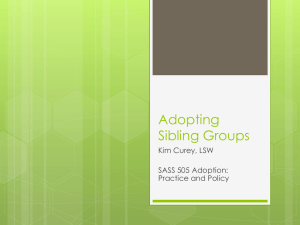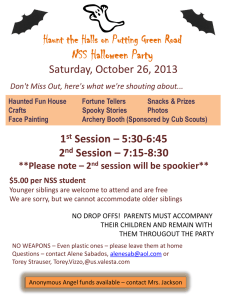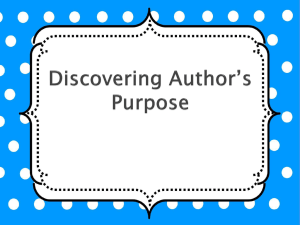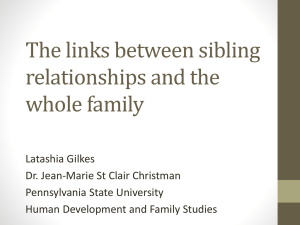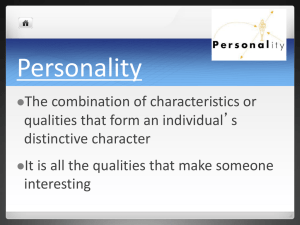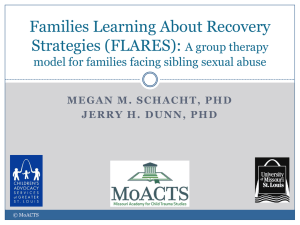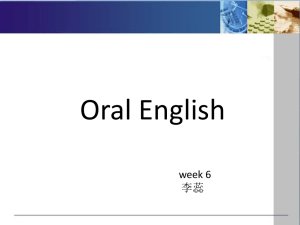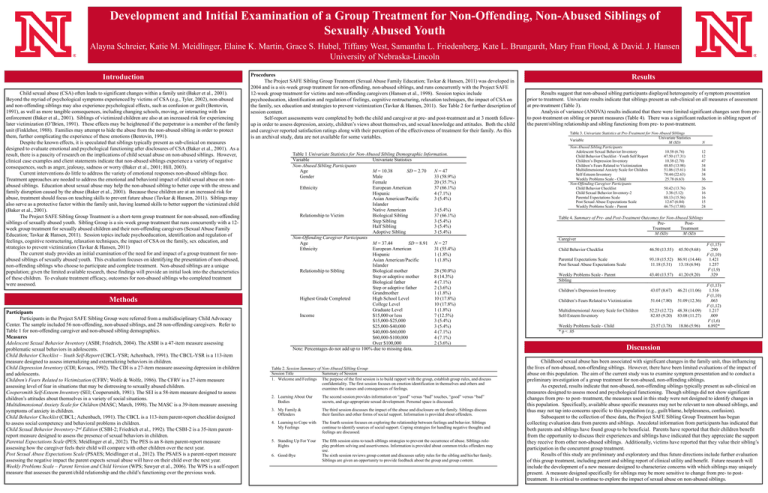
Development and Initial Examination of a Group Treatment for Non-Offending, Non-Abused Siblings of
Sexually Abused Youth
Alayna Schreier, Katie M. Meidlinger, Elaine K. Martin, Grace S. Hubel, Tiffany West, Samantha L. Friedenberg, Kate L. Brungardt, Mary Fran Flood, & David. J. Hansen
University of Nebraska-Lincoln
Introduction
Child sexual abuse (CSA) often leads to significant changes within a family unit (Baker et al., 2001).
Beyond the myriad of psychological symptoms experienced by victims of CSA (e.g., Tyler, 2002), non-abused
and non-offending siblings may also experience psychological effects, such as confusion or guilt (Bentovin,
1991), as well as more tangible consequences, including changing schools, moving, or interacting with law
enforcement (Baker et al., 2001). Siblings of victimized children are also at an increased risk for experiencing
later victimization (O’Brien, 1991). These effects may be heightened if the perpetrator is a member of the family
unit (Finklehor, 1988). Families may attempt to hide the abuse from the non-abused sibling in order to protect
them, further complicating the experience of these emotions (Bentovin, 1991).
Despite the known effects, it is speculated that siblings typically present as sub-clinical on measures
designed to evaluate emotional and psychological functioning after disclosures of CSA (Baker et al., 2001). As a
result, there is a paucity of research on the implications of child sexual abuse on non-abused siblings. However,
clinical case examples and client statements indicate that non-abused siblings experience a variety of negative
consequences, such as anger, jealousy, sadness or worry (Baker et al., 2001; Hill, 2003).
Current interventions do little to address the variety of emotional responses non-abused siblings face.
Treatment approaches are needed to address the emotional and behavioral impact of child sexual abuse on nonabused siblings. Education about sexual abuse may help the non-abused sibling to better cope with the stress and
family disruption caused by the abuse (Baker et al., 2001). Because these children are at an increased risk for
abuse, treatment should focus on teaching skills to prevent future abuse (Tavkar & Hansen, 2011). Siblings may
also serve as a protective factor within the family unit, having learned skills to better support the victimized child
(Baker et al., 2001).
The Project SAFE Sibling Group Treatment is a short-term group treatment for non-abused, non-offending
siblings of sexually abused youth. Sibling Group is a six-week group treatment that runs concurrently with a 12week group treatment for sexually abused children and their non-offending caregivers (Sexual Abuse Family
Education; Tavkar & Hansen, 2011). Session topics include psychoeducation, identification and regulation of
feelings, cognitive restructuring, relaxation techniques, the impact of CSA on the family, sex education, and
strategies to prevent victimization (Tavkar & Hansen, 2011)
The current study provides an initial examination of the need for and impact of a group treatment for nonabused siblings of sexually abused youth. This evaluation focuses on identifying the presentation of non-abused,
non-offending siblings who choose to participate and complete treatment. Non-abused siblings are a unique
population; given the limited available research, these findings will provide an initial look into the characteristics
of these children. To evaluate treatment efficacy, outcomes for non-abused siblings who completed treatment
were assessed.
Methods
Participants
Participants in the Project SAFE Sibling Group were referred from a multidisciplinary Child Advocacy
Center. The sample included 56 non-offending, non-abused siblings, and 28 non-offending caregivers. Refer to
Table 1 for non-offending caregiver and non-abused sibling demographics.
Measures
Adolescent Sexual Behavior Inventory (ASBI; Friedrich, 2004). The ASBI is a 47-item measure assessing
problematic sexual behaviors in adolescents.
Child Behavior Checklist – Youth Self-Report (CBCL-YSR; Achenbach, 1991). The CBCL-YSR is a 113-item
measure designed to assess internalizing and externalizing behaviors in children.
Child Depression Inventory (CDI; Kovacs, 1992). The CDI is a 27-item measure assessing depression in children
and adolescents.
Children’s Fears Related to Victimization (CFRV; Wolfe & Wolfe, 1986). The CFRV is a 27-item measure
assessing level of fear in situations that may be distressing to sexually abused children.
Coopersmith Self-Esteem Inventory (SEI; Coopersmith, 1981). The SEI is a 58-item measure designed to assess
children’s attitudes about themselves in a variety of social situations.
Multidimensional Anxiety Scale for Children (MASC; March, 1998). The MASC is a 39-item measure assessing
symptoms of anxiety in children.
Child Behavior Checklist (CBCL; Achenbach, 1991). The CBCL is a 113-item parent-report checklist designed
to assess social competency and behavioral problems in children.
Child Sexual Behavior Inventory-2nd Edition (CSBI-2; Friedrich et al., 1992). The CSBI-2 is a 35-item parentreport measure designed to assess the presence of sexual behaviors in children.
Parental Expectations Scale (PES; Meidlinger et al., 2012). The PES is an 8-item parent-report measure
assessing how the caregiver feels their child will compare with other children over the next year.
Post Sexual Abuse Expectations Scale (PSAES; Meidlinger et al., 2012). The PSAES is a parent-report measure
assessing the negative impact the parent expects sexual abuse will have on their child over the next year.
Weekly Problems Scale – Parent Version and Child Version (WPS; Sawyer et al., 2006). The WPS is a self-report
measure that assesses the parent/child relationship and the child’s functioning over the previous week.
Procedures
The Project SAFE Sibling Group Treatment (Sexual Abuse Family Education; Tavkar & Hansen, 2011) was developed in
2004 and is a six-week group treatment for non-offending, non-abused siblings, and runs concurrently with the Project SAFE
12-week group treatment for victims and non-offending caregivers (Hansen et al., 1998). Session topics include
psychoeducation, identification and regulation of feelings, cognitive restructuring, relaxation techniques, the impact of CSA on
the family, sex education and strategies to prevent victimization (Tavkar & Hansen, 2011). See Table 2 for further description of
session content.
Self-report assessments were completed by both the child and caregiver at pre- and post-treatment and at 3 month followup in order to assess depression, anxiety, children’s views about themselves, and sexual knowledge and attitudes. Both the child
and caregiver reported satisfaction ratings along with their perception of the effectiveness of treatment for their family. As this
is an archival study, data are not available for some variables.
Table 1 Univariate Statistics for Non-Abused Sibling Demographic Information.
Variable
Univariate Statistics
Non-Abused Sibling Participants
Age
M = 10.38
SD = 2.70
N = 47
Gender
Male
33 (58.9%)
Female
20 (35.7%)
Ethnicity
European American
37 (66.1%)
Hispanic
4 (7.1%)
Asian American/Pacific
3 (5.4%)
Islander
Native American
3 (5.4%)
Relationship to Victim
Biological Sibling
37 (66.1%)
Step Sibling
3 (5.4%)
Half Sibling
3 (5.4%)
Adoptive Sibling
3 (5.4%)
Non-Offending Caregiver Participants
Age
M = 37.44
SD = 8.91 N = 27
Ethnicity
European American
31 (55.4%)
Hispanic
1 (1.8%)
Asian American/Pacific
1 (1.8%)
Islander
Relationship to Sibling
Biological mother
28 (50.0%)
Step or adoptive mother
8 (14.3%)
Biological father
4 (7.1%)
Step or adoptive father
2 (3.6%)
Grandmother
1 (1.8%)
Highest Grade Completed
High School Level
10 (17.8%)
College Level
10 (17.8%)
Graduate Level
1 (1.8%)
Income
$15,000 or less
7 (12.5%)
$15,000-$25,000
3 (5.4%)
$25,000-$40,000
3 (5.4%)
$40,000-$60,000
4 (7.1%)
$60,000-$100,000
4 (7.1%)
Over $100,000
2 (3.6%)
Note: Percentages do not add up to 100% due to missing data.
Table 2. Session Summary of Non-Abused Sibling Group
Session Title
Summary of Session
1. Welcome and Feelings The purpose of the first session is to build rapport with the group, establish group rules, and discuss
confidentiality. The first session focuses on emotion identification in themselves and others and
examines the causes and consequences of feelings.
2. Learning About Our
Bodies
The second session provides information on “good” versus “bad” touches, “good” versus “bad”
secrets, and age-appropriate sexual development. Personal space is discussed.
3. My Family &
Offenders
The third session discusses the impact of the abuse and disclosure on the family. Siblings discuss
their families and other forms of social support. Information is provided about offenders.
4. Learning to Cope with
My Feelings
The fourth session focuses on exploring the relationship between feelings and behavior. Siblings
continue to identify sources of social support. Coping strategies for handling negative thoughts and
feelings are discussed.
5. Standing Up For Your
Rights
The fifth session aims to teach siblings strategies to prevent the occurrence of abuse. Siblings roleplay problem solving and assertiveness. Information is provided about common tricks offenders may
use.
The sixth session reviews group content and discusses safety rules for the sibling and his/her family.
Siblings are given an opportunity to provide feedback about the group and group content.
6. Good-Bye
Results
Results suggest that non-abused sibling participants displayed heterogeneity of symptom presentation
prior to treatment. Univariate results indicate that siblings present as sub-clinical on all measures of assessment
at pre-treatment (Table 3).
Analysis of variance (ANOVA) results indicated that there were limited significant changes seen from preto post-treatment on sibling or parent measures (Table 4). There was a significant reduction in sibling report of
the parent/sibling relationship and sibling functioning from pre- to post-treatment.
Table 3. Univariate Statistics at Pre-Treatment for Non-Abused Siblings
Univariate Statistics
Variable
M (SD)
Non-Abused Sibling Participants
Adolescent Sexual Behavior Inventory
10.58 (6.76)
Child Behavior Checklist –Youth Self Report
47.50 (17.31)
Children’s Depression Inventory
10.38 (2.70)
Children’s Fears Related to Victimization
48.85 (13.98)
Multidimensional Anxiety Scale for Children
51.06 (15.61)
Self-Esteem Inventory
70.44 (22.63)
Weekly Problems Scale - Child
25.78 (6.63)
Non-Offending Caregiver Participants
Child Behavior Checklist
50.42 (13.76)
Child Sexual Behavior Inventory-2
3.38 (5.12)
Parental Expectations Scale
88.13 (15.56)
Post Sexual Abuse Expectations Scale
12.67 (6.04)
Weekly Problems Scale - Parent
46.75 (17.88)
N
12
12
47
34
34
34
36
26
16
16
15
24
Table 4. Summary of Pre- and Post-Treatment Outcomes for Non-Abused Siblings
PrePostTreatment
Treatment
M (SD)
M (SD)
Caregiver
Child Behavior Checklist
46.50 (13.55)
45.50 (9.68)
Parental Expectations Scale
Post Sexual Abuse Expectations Scale
93.18 (15.52)
11.18 (5.31)
86.91 (14.44)
13.18 (6.94)
Weekly Problems Scale - Parent
Sibling
43.40 (13.57)
41.20 (9.20)
Children’s Depression Inventory
43.07 (8.67)
46.21 (11.06)
Children’s Fears Related to Victimization
51.64 (7.80)
51.09 (12.36)
Multidimensional Anxiety Scale for Children
Self-Esteem Inventory
52.23 (12.72)
82.85 (9.20)
48.38 (14.09)
83.08 (11.27)
Weekly Problems Scale - Child
* p < .05
23.57 (3.78)
18.86 (5.96)
F (1,15)
.290
F (1,10)
1.421
1.257
F (1,9)
.329
F (1,13)
1.516
F (1,10)
.063
F (1,12)
1.217
.009
F (1,6)
6.892*
Discussion
Childhood sexual abuse has been associated with significant changes in the family unit, thus influencing
the lives of non-abused, non-offending siblings. However, there have been limited evaluations of the impact of
abuse on this population. The aim of the current study was to examine symptom presentation and to conduct a
preliminary investigation of a group treatment for non-abused, non-offending siblings.
As expected, results indicate that non-abused, non-offending siblings typically present as sub-clinical on
measures designed to assess mood and psychological functioning. Though siblings did not show significant
changes from pre- to post- treatment, the measures used in this study were not designed to identify changes in
this population. Specifically, available abuse specific measures may not be relevant to non-abused siblings, and
thus may not tap into concerns specific to this population (e.g., guilt/blame, helplessness, confusion).
Subsequent to the collection of these data, the Project SAFE Sibling Group Treatment has begun
collecting evaluation data from parents and siblings. Anecdotal information from participants has indicated that
both parents and siblings have found group to be beneficial. Parents have reported that their children benefit
from the opportunity to discuss their experiences and siblings have indicated that they appreciate the support
they receive from other non-abused siblings. Additionally, victims have reported that they value their sibling’s
participation in the concurrent group treatment.
Results of this study are preliminary and exploratory and thus future directions include further evaluation
of this group treatment, including parent and sibling report of clinical utility and benefit. Future research will
include the development of a new measure designed to characterize concerns with which siblings may uniquely
present. A measure designed specifically for siblings may be more sensitive to change from pre- to posttreatment. It is critical to continue to explore the impact of sexual abuse on non-abused siblings.

